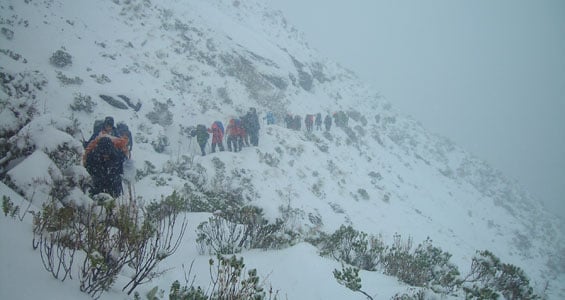There is no cellphone coverage.
The track is not suitable for all walkers
It is not recommended for children under the age of 10, due to the exposed mountainous environment and often adverse weather conditions. Parts of the Milford Track are exposed, steep, slippery, rough and muddy. On the third day you will climb over 500 m to Omanui/McKinnon Pass and then descend 1000 m to Dumpling Hut. On the fourth day you must walk 18 km, reaching Sandfly Point in time to meet the early afternoon boat.
Weather conditions
Weather conditions can change quickly in any season. Fiordland National Park experiences very high rainfall (up to 9000 mm per year). Cold temperatures, snow, strong winds and heavy rain can occur at any time of the year. Be prepared for all conditions. Track closures are possible and may affect your travel itinerary. Travel insurance is recommended.
Avalanche risk
The risk of avalanche can extend into December. During the Great Walks season DOC manages this risk to a low level and walkers may be flown (at their cost) over dangerous sections.
Weather forecast
Milford Track weather forecast – NIWA website
View current conditions on the Omanui/McKinnon Pass webcam

Milford Track in November – cold temperatures, snow, strong winds and heavy rain can occur anytime.
Stay safe when crossing rivers
If you plan to cross unbridged rivers, know how to cross safely and be prepared for if you cannot cross.
Do not cross if the river is flooded, you cannot find safe entry and exit points or are unsure it’s safe. Turn back or wait for the river to drop. If in doubt, stay out.
Take precautions not to spread didymo
Didymo is present in Lake Te Anau and Milford Sound, but currently not in the pristine Clinton and Arthur rivers.
All visitors should take precautions to avoid spreading didymo. Be extra mindful when moving from the lake to the rivers along the Milford Track, and from the Fresh Water Basin in Milford Sound to the Arthur River.
Use the Check, Clean Dry guidelines to ensure didymo is not spread further. Do not take water from these areas, avoid filling water bottles and swimming here (in the rivers after swimming the lakes).
More information about preventing the spread of freshwater pests in Fiordland National Park.